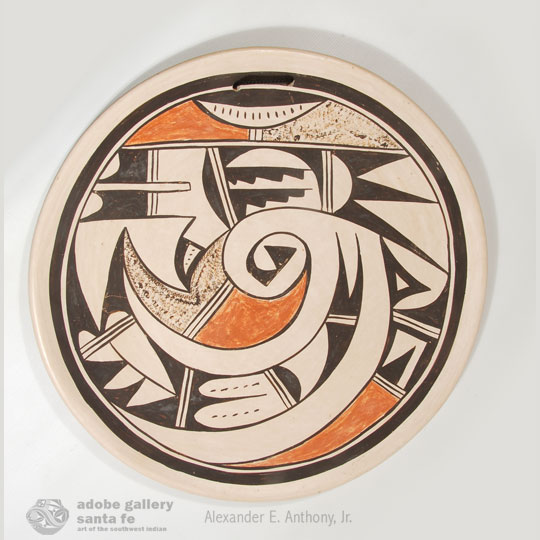Adobe Gallery Blog
Polychrome Hopi Pueblo Plate with Spiral Bird Design by Evelyn Poolheco - C4052E
 The Hopi have lived on three mesas in northeastern Arizona for more than 1,000 years. Today they live in 12 separate villages on or below the three Mesas. The Hopi language is part of the Uto-Aztecan language group, one of the largest Native American language groups. Tribes speaking Uto-Aztecan languages range geographically from the Shoshone of northern Idaho to the Pipil of El Salvador. On Hopi's First Mesa, a group of relative newcomers from the Rio Grande Tewa Pueblos speak the Tewa language.
The Hopi have lived on three mesas in northeastern Arizona for more than 1,000 years. Today they live in 12 separate villages on or below the three Mesas. The Hopi language is part of the Uto-Aztecan language group, one of the largest Native American language groups. Tribes speaking Uto-Aztecan languages range geographically from the Shoshone of northern Idaho to the Pipil of El Salvador. On Hopi's First Mesa, a group of relative newcomers from the Rio Grande Tewa Pueblos speak the Tewa language.
In the late 19th Century, Jesse Walter Fewkes led the Hemenway Expedition to the American Southwest to do anthropological studies of the Hopi and Zuni tribes. While there, he undertook the excavation of the ancient Hopi village of Sikyatki where he found a large number of ceramic wares. Sikyatki Polychrome was produced from about AD 1375 to AD 1625. Fewkes worked with potters on First Mesa to catalog the designs and record them. At that time there was a revival of using Sikyatki designs on Hopi pottery. The best-known potter who began to utilize the ancient designs was Nampeyo of Hano, but many other potters also began to incorporate the curvilinear bird and feather designs into their pottery. The revival of Sikyatki designs on Hopi pottery continues to this day.
To purchase or read more click here..
#adobegallery #SouthwestIndianPottery #HopiPueblo #PuebloPottery #SouthwestIndianArt #SantaFePottery #FinePuebloPottery #EvelynPoolheco

